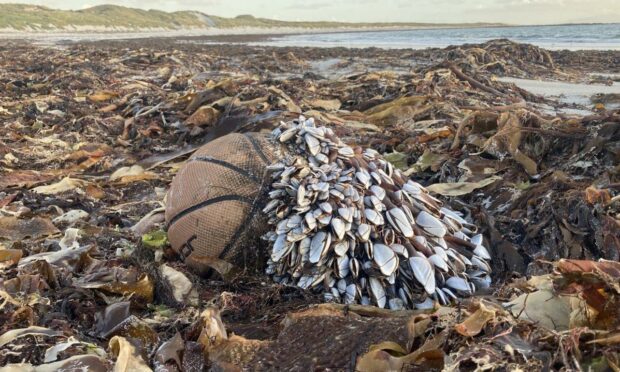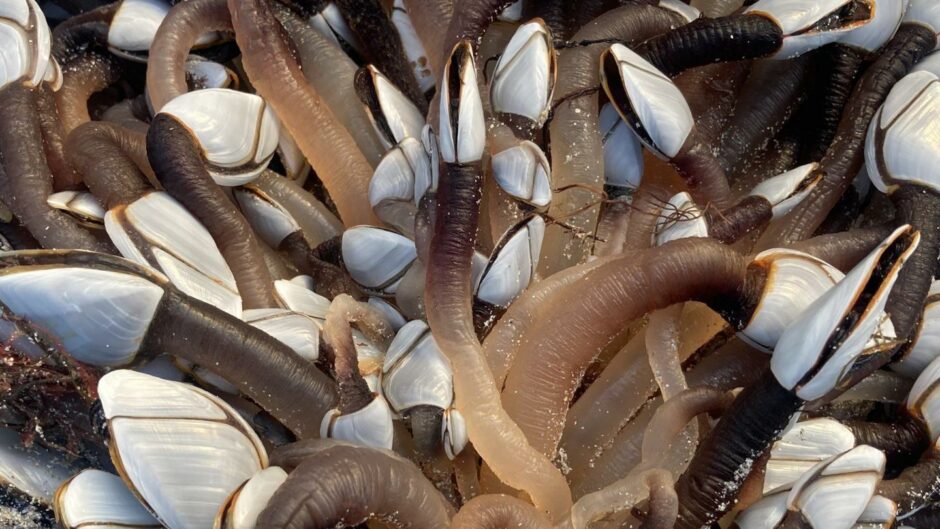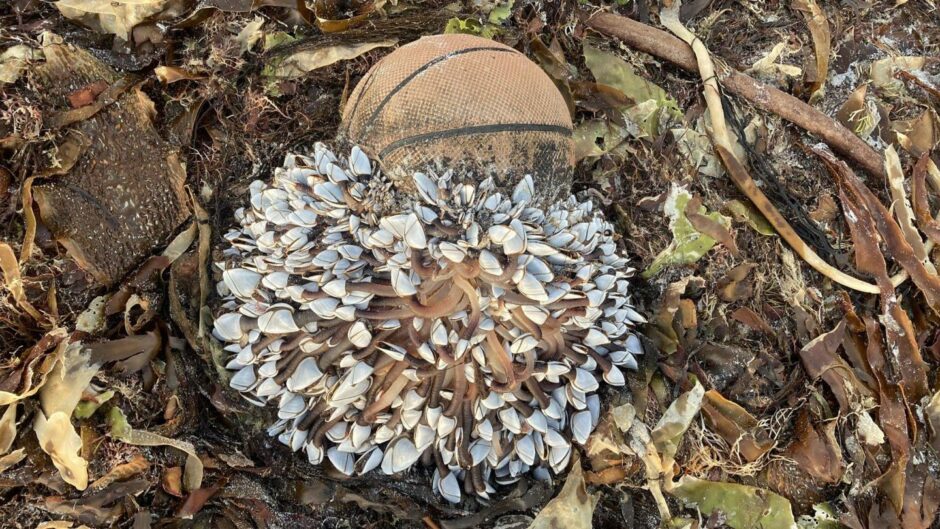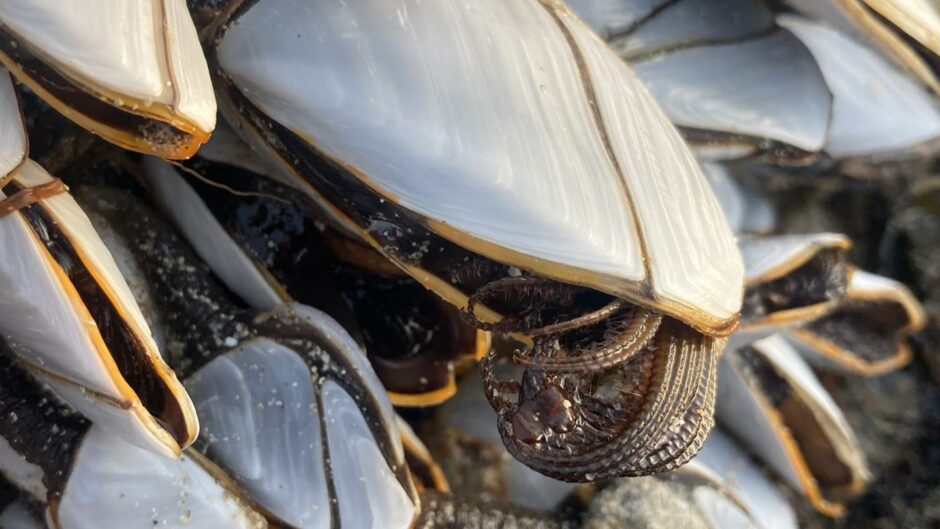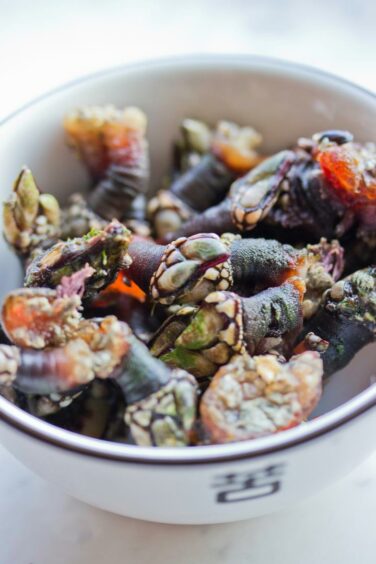A basketball carrying hundreds of alien-looking creatures has washed up on a Western Isles beach, after it is thought to have floated across the Atlantic from North America.
Ecologist and photographer Peter Stronach said he was “astonished” when he happened upon the “bizarre” sight at Aird an Runair on North Uist.
Half of the ball was coated in a “huge mass” of goose barnacles.
Some members of the species, such as the ones Peter found, spend their lives attached to floating debris.
Many of the bizarre, worm-like animals were still alive when Peter found them, however the castaways and are doomed to die in the cold waters of Scotland.
Although goose barnacles would typically hitch a ride on the likes of kelp or tree branches, many beachcombers nowadays find them growing from manmade flotsam like this basketball — evidence of humanity’s impact on the marine environment.
‘They were wiggling about’
More used to spotting geese than goose barnacles, keen bird-watcher Peter’s curiosity was piqued when he saw the Jordan-brand basketball.
He said: “I saw in the distance a basketball, which is a weird enough thing to see on a beach on North Uist, and when I got closer I noticed this huge mass of goose barnacles on the underside.
“I couldn’t believe it, I had seen them once before on Harris, but this was the first time I’d seen such a huge mass.
“Most of them were still living, I tried to put them back in the water but they’re not a cold water species at all, so they won’t be lasting long.
“It’s so bizarre, it really is. They were wiggling about, the shells were opening up and their tentacles were coming out, trying to get food.”
Where did the basketball and its barnacle buddies come from?
Orkney-based Martin Gray, a naturalist who has worked on nature expedition cruises across the world and has been a beachcomber for most of his life, said he is “certain” the basketball Peter found on North Uist came from North America.
He explained the ball and its passengers would have made their way from the other side of Atlantic in a powerful current.
Martin said: “They are animals which latch onto material afloat in the warm water current that runs past Scotland.
“This current begins life in the Caribbean, and it rattles up the coast of Florida at four knots, it’s like a powerful river in the ocean.”
He explained that winds can sometimes blow rubbish being carried in the current on to shore, and believes this is what happened to Peter’s basketball.
He continued: “Where Peter’s found that is looking out to the Atlantic, and this thing has been dropped out of the current by sustained westerly winds and driven ashore.
“We don’t know the conditions they experienced in the crossing.
“If they’re floating through relatively warm, relatively nutrient-rich water, they can grow quite big quite quickly.
“But if they happen to be spending time in the cold, nutrient poor water, they can grow less quickly.
“But from looking at that photo, it looks to me like those things are a year and a half to two years old, and for certain it’s come from the American side.”
Hitching a ride on marine litter
This insulated rubber boot came ashore in Orkney earlier this month, completely covered in goose barnacles. Material embedded in the warm current is very often colonised by goose barnacles on this side of the Atlantic pic.twitter.com/wI9RL6o9QW
— Martin Gray (@peediepuss) October 30, 2021
Martin says he has come across many bits of manmade debris carrying goose barnacles over the years, including fluorescent tubes and rubber boots.
He continued: “These things are not fussy what they attach to, they have the biological imperative to grow on things as tiny little planktonic larvae, and in their earliest stages they just attach to stuff.
“And there’s just so much more stuff out there at sea nowadays, plastic and god knows what else.
This fluorescent tube landed intact on a stony Orkney beach today. The growths of algae and hydroids along with the big Goose Barnacles attached tell of a long float to here. Easily long enough to cross the whole ocean. pic.twitter.com/jmdbZ2cHcl
— Martin Gray (@peediepuss) October 17, 2021
“We still find them on big lumps of wood and that, but there’s an awful lot of plastic we find them stuck to.
“Humanity’s influence on the ocean has an effect on these things.
“But it’s not all doom and gloom, they become food for birds and marine life on this side, and their decaying remains nourish our coastal seas.”
Can you eat them?
Although a separate species of goose barnacle is eaten as an expensive delicacy in Spain and Portugal, Martin explained the kinds that typically wash up on Scottish shorelines are certainly not tasty, as he found out first hand.
“The ones in Spain grow attached to rocks on the shore, in intertidal environments, whereas these are pelagic and grow on floating material,” he said.
“You’re not meant to eat them, although, I have tried them just to see and it’s like eating a rubber tube that’s full of briny sludge.
“It was absolutely horrendous. The best part was the shell.
“You hear people saying ooh, goose barnacles are good to eat and they cost a fortune in Spain, even though they’re a different type of species, and I thought, och well, it can’t be that different.
“God. Never again. I fried it, but had to chuck the pan away afterwards.”
You may also like:
- Gallery: Divers and Kayakers clear Stonehaven coves of plastic pollution
- RAF Lossiemouth volunteers clear coastline ahead of Great British Beach Clean
- Construction workers hit the beach and collect 12 tonnes of litter
